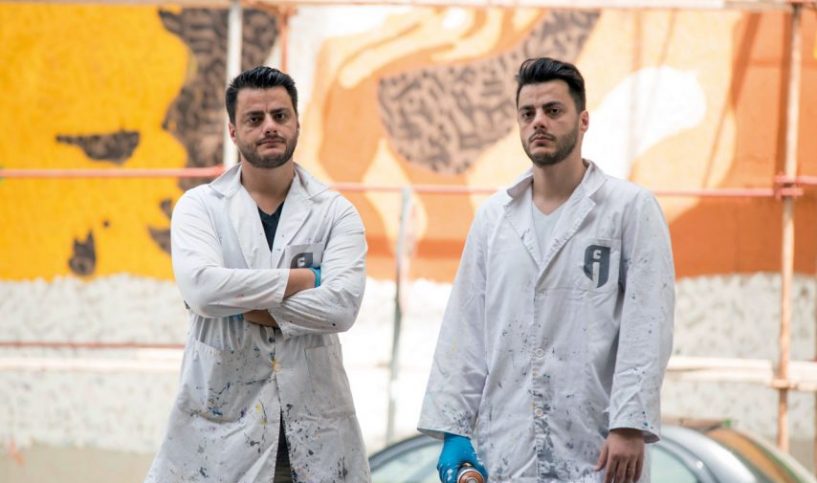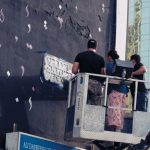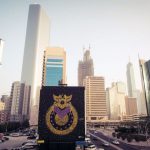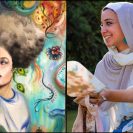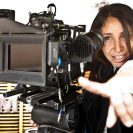If you’ve ever roamed the streets of Beirut, you’ve probably passed by one of ASHEKMAN’s iconic murals in Beirut, admiring the spectacular calligraffiti commemorating iconic Lebanese talents such as Sabah, or contemplating the magnitude of how simplistic Arabic-dubbed cartoon characters from your childhood like Captain Majid and Grendizer could mean so much more to you as an adult. That’s the beauty behind ASHEKMAN’s work, as the Beirut-based movement is taking back the streets of Lebanon, along with different walls around the world, in an artistic battle to preserve Arabic culture through calligraffiti. Last month, the people of Kuwait were given the opportunity to witness this movement first hand when ASHEKMAN worked tirelessly for days to put up a stunning piece in the heart of Kuwait City in collaboration with Redbull Kuwait’s Second Urban Culture Week and Jedariyat.
Established in 2001, the Beirut-based movement that is Ashekman was conceived by identical twin brothers Mohamed and Omar Kabbani, and has been stirring the minds of spectators ever since. An Arabic street art concept that includes Arabic graffiti, calligraphy, Arabic rap music and Arabic street wear, the Kabbani twins are on a mission to revive the region’s rich cultural identity and history through art, employing their ability to deliver an urban visual twist on our classical Arabic language and calligraphy to make it more appealing in the minds of people worldwide. The twins knew that they had a future in art at an early age, and credit their artsy genes to their mother, who is a painter. When we asked the twins about which of their initiatives came first, they passionately deem that “[it] all came at the same time. We wanted to spread our message through audio and visual mediums, and all the elements eventually complimented each other.”
As self-made artists, Mohamed and Omar began their journey with ASHEKMAN from scratch fifteen years ago, and their passion for urban culture fuels their creativity. In constantly creating new materials through visuals or audio, we can see the evolution of their work, and the increasing sharpness in the clarity of their message. At a time where globalization has invaded our perceptions of mainstream media, ASHEKMAN’s work proves to be more important than ever.
After attending a French school and graduating from an American university, the twins wanted to preserve their identity and represent Arabic culture in a positive way as a response to the increasing negative propaganda and that our region receives. A real phenomenon that they believe doesn’t represent the reality of what really goes on in our region. Growing up in the midst of the Lebanese civil war in the 80’s, when fighting militias used to control the streets and tag their slogans on walls, the ASHEKMAN twins realized that the streets could be controlled differently to incite positive change, and through their slogan ‘the street is ours’, we see them reinterpreting the tragic norms of days past in replacing rifles with spray cans, believing that art is stronger than any outlaw militias and today’s terrorism.
In following ASHEKMAN’s journey, you quickly learn that there is no school that teaches street art, as the movement’s evolution is a product of hard work and experimenting to learn from trials and tribulations. Arriving among the first artists to adopt Arabic graffiti and calligraffiti, the twins noticed that ‘style biting’ is perhaps one of the greatest challenges that they face, humbled when people tag them online on work that isn’t theirs, but emulates all of the ASHEKMAN style elements. In seeing the street art scene grow in diversity, the twins believe that the regional urban culture is now developing its own identity, regardless of flattering re-interpretations of their style. Because ASHEKMAN emerged at a time when street art and graffiti were considered as a form of vandalism, the way in which their work is perceived is changing, as the region’s perception of street art is shifting. Today, we see renowned artists commissioned to create fantastical work. On this, ASHEKMAN noted that “with the Arab Spring, graffiti was utilized as a tool for expression. Nowadays there are different perceptions regarding graffiti, but it’s becoming widely accepted as a form of art especially when big art galleries embraced and endorsed a lot of artists.” While street art might not be officially legitimized, its promotion through endorsements and collaborating with creative entities have helped spread the word.
The ASHEKMAN twins believe that their work “mirrors society, and it’s actually a spontaneous reaction to events that surround us.” The ASHEKMAN flair is first triggered by a specific happening or event, where ideas come first, followed by the mediums and how a specific project could come to life. At the heart of their work lies collaboration, whether it is the brothers working together, or when they are working with other creative entities in Lebanon and the region. Their most recent work in Kuwait illustrates this most, as the twins have been planning this collaboration for quite some time.
Speaking on their most recent collaboration, creating the ‘People’s Champ’ in the form of Grendizer using Arabic calligraffiti wouldn’t have been possible without the help of Redbull Kuwait and the local street art initiative Jedariyat, along with the support of Kuwait’s local creative community who came together for this specific project including Jotun Paints, Montana Cans, ArtSpace Kuwait, local photographer Yousef Al Nasser and Frame Rate Production amongst many others. The twins further highlighted that, “the concept, art and execution was solely done by the ASHEKMAN twins, and the great people at Red Bull Kuwait and Jedariayat managed the logistics along with many other creatives to make this happen.” During their short visit to Kuwait during Red Bull Kuwait’s Second Culture week, they met artists and writers alike and got a taste for the local creative scene through the various activities organized at Kuwait Artspace café, and noted how the different styles and backgrounds that make up Kuwait’s scene make for a rich and diverse artistic offering. Also close friends with one of Kuwait’s pioneering graffiti artist Monstariam, who collaborated with the twins on a piece when he visited Beirut two years ago, ASHEKMAN created a sequel with Monstariam after completing the Grendizer mural in Kuwait.
In looking to the future, ambition drives the ASHEKMAN force, and the sky’s the limit for the Kabbani twins. From working on realizing their dream mural location in Beirut’s Burj el Murr, the Lebanese capital’s tallest tower abandoned since the 80s civil war, to plans for new calligraffiti murals in the Middle East and Europe, the twins are also releasing new music and a limited edition clothing line in an effort to further serve their mission—portraying Arabic culture in a positive way.
For more information about ASHEKMAN, visit ashekman.com and follow their updates on Instagram @Ashekman. bazaar would like to thank ASHEKMAN, Red Bull Kuwait and Jedariyat, along with all the local creatives who brought this feature to life. Photography by Karim Sakr, Loukman Nasreddine, and Yousef Al Nasser.

